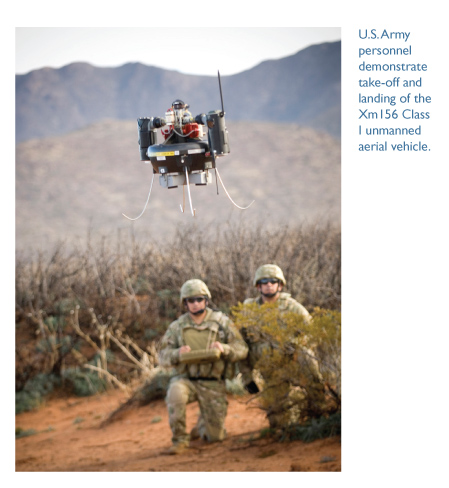Drones in U.S. Flight Paths: What Could Go Wrong?
 On February 14 President Obama signed the FAA Modernization and Reform Act of 2012 into law, authorizing the Federal Aviation Administration to integrate unmanned aerial vehicles (known as drones) into the national airspace system by 2015. The first order of business under the act is to establish six sites within a year where the military and others can fly unmanned aircraft in the vicinity of regular air traffic in order to demonstrate that it can be done safely.
On February 14 President Obama signed the FAA Modernization and Reform Act of 2012 into law, authorizing the Federal Aviation Administration to integrate unmanned aerial vehicles (known as drones) into the national airspace system by 2015. The first order of business under the act is to establish six sites within a year where the military and others can fly unmanned aircraft in the vicinity of regular air traffic in order to demonstrate that it can be done safely.
On March 9 the FAA requested public comment in the form of questions regarding requirements and oversight of such test sites. Responses were provided on May 8 by an activist group called Not 1 More Acre!, which has long fought the Pentagon’s efforts (and those of private contractors) to claim fragile prairie lands in Colorado and New Mexico for drone testing—efforts the group says have been in violation of environmental and cultural protection laws.
While the FAA asked all the wrong questions in the March 9 edition of the Federal Register, Not 1 More Acre! provided a lot of the right answers. (When the drone accidents start and you’re told “nobody could have known,” refer them to my own and this group’s comments.)
One of the questions posed by the FAA was this:
The Congressional language asks the FAA to consult with and leverage the resources of the Department of Defense and NASA in this effort. Since many public operators already have access to test ranges and control the management and use of those ranges, should the management of these new test ranges be held by local governments or should private entity [sic] schedule and manage the airspace?
Not 1 More Acre! replied:
Neither. Although the pilot UAS [Unmanned Aircraft System] program is a congressional mandate, and the timelines are accelerated, the complexities and potential dangers of integration of UAS into civilian airspace must not be delegated to local governments or private organizations in the name of expediency, entrepreneurship, or profit. … The wording of Question A suggests that the FAA is contemplating abdicating its inherent authority to manage the NAS [National Airspace System] by ceding broad discretion over UAS flight operations.
… The primary driver of the move to integration has clearly been contractors funded by the DOD [Department of Defense], working in concert with the secretive Joint Special Forces Operation Command, the Department of Homeland Security, and the CIA, among others. … Private defense contractors increasingly woo local law enforcement agencies and other community groups with grants to help fund the purchase of new UAS. The FAA should not allow any other federal agency to usurp its authority over the NAS or circumvent the pre-decisional public disclosure requirements of NEPA [National Environmental Policy Act] including agencies like the CIA, NASA, and JSOC which are not transparent or accountable to the public.
In response to a Freedom of Information Act lawsuit brought by the Electronic Frontier Foundation, the FAA released a list in April of sixty-three entities nationwide—including branches of the military, police forces, corporations, universities, and city and county governments—that have been authorized to test-fly drones within the United States. (Which begs the question of whether they’re already doing so in national airspace or if they’re waiting for the six test sites to be selected.) Uses of drones (along with their size) vary, from farmers looking to count cows and monitor crops, to law enforcement agents on the lookout for drug smugglers, to search-and-rescue efforts. Even the media seek the use of such surveillance technology in their reporting.
 Toward these and other ends, Congress has authorized putting up to 30,000 drones in U.S. skies within the next eight years. That is to say, Congress passed the bill. Lobbyists from the Association for Unmanned Vehicle Systems International openly took credit for having written it.
Toward these and other ends, Congress has authorized putting up to 30,000 drones in U.S. skies within the next eight years. That is to say, Congress passed the bill. Lobbyists from the Association for Unmanned Vehicle Systems International openly took credit for having written it.
Domestic drones have civil liberties groups in an uproar. But the potential for the strongest resistance probably lies in forming partnerships with peace groups already outraged that drones are being used to murder large numbers of people abroad.
As political activist and Code Pink co-founder Medea Benjamin documents in her new book, Drone Warfare: Killing by Remote Control, the United States has avoided detaining people, only to murder them with a drone days later. The president has even authorized using drones to kill Americans in Yemen, including a drone strike on Anwar al-Awlaki, and a later strike that killed his teenage son.
And using drones for warfare isn’t always as expedient as billed either. In February 2002 a drone pilot thought he’d killed Osama bin Laden, but the victim turned out to be an innocent man. Expert observers, including Shahzad Akbar, a Pakistani lawyer representing drone victims, believe the vast majority of drone victims are not the individuals who were targeted—which is not to suggest any moral or legal case for killing those who are targeted. Often victims are not counted as “civilians” because they were carrying guns, but in some areas all men carry guns. Noor Behram, who photographs drone victims, says, “For every ten to fifteen people, maybe they get one militant.”
Benjamin tells of families shattered by drones and the hatred created by the constant buzzing sound the unmanned aerial vehicles make in the skies above as civilians go about their business, knowing that at any instant they can be killed. When the drones strike in Pakistan, local death squads swoop into the area to grab anyone whom they suspect of having collaborated with the Americans, and so families live in fear of both the drones and the raids that follow. Over a million people, by Amnesty International’s estimate, have fled the areas of heavy drone bombing.
Afghans have killed CIA drone pilots and other U.S. officials inside their offices. Drones have even killed Americans in “friendly fire,” including on April 6, 2011, in Afghanistan. And there have been cases of drone “pilots” working in the United States committing suicide. They are suffering extremely high rates of stress and burnout, according to the Air Force, because while pilots who actually fly in planes often don’t see who they kill, drone pilots may watch a family for days and come to know their faces, only to blow them all up and watch the suffering. A Pakistani who tried to detonate a car bomb in Times Square in 2010 said it was revenge for drone attacks. In the fall of 2011, a Massachusetts man, Rezwan Ferdaus, was arrested and accused of plotting to attack the Pentagon and the U.S. Capitol with drones that would crash themselves into the buildings. The Obama administration claims to have limited its drone strikes in Somalia so as to avoid turning a regional threat into a group with the determination to attack the United States—even while expanding drone use in Yemen, creating the same risk.
Drones have also been falsely marketed as a financially affordable way to make war. While initially cheaper than manned planes, unmanned drones of the sort used now tend to require many more personnel: according to Benjamin’s book, 168 people are needed to keep a Predator drone in the air for twenty-four hours, plus nineteen analysts to process the videos created by a drone. And to make matters worse, they tend to crash. They can even “go rogue,” losing contact with their operators and flying off on their own. And, reports Benjamin, the U.S. Navy has a drone that self-destructs if you accidentally touch the space bar on the computer keyboard. Drones also tend to supply so-called enemies with information, including the endless hours of video they record, and to infect U.S. military computers with viruses.
But these are the sorts of SNAFUs that come with any project lacking oversight, accountability, or cost controls. One has to suspect that the companies with the biggest drone contracts, military or civilian, haven’t invested in developing the best technologies but in paying off the most Congress members.
So while I’d like to ask the FAA how domestic surveillance drones possibly comply with the Fourth Amendment, the bigger question really is: what could go wrong?
